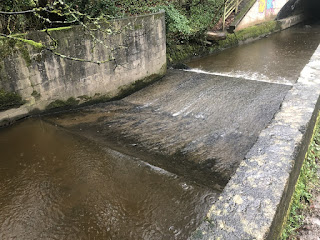06/01/2022 Weirs and Geese
Today, Project Officer Samuel Gibson and I met with Mike Flaherty. While we work primarily with the River Douglas, Mike works with the River Tawd. It’s essential for us to get to know both rivers as the Tawd feeds into the Douglas and shares much of the same wildlife. Mike has lived in Skelmersdale his whole life and has an abundance of local knowledge on the Tawd and Douglas Rivers.
Mike is part of the Friends of Tawd Valley committee. The project seeks to engage the local community and wildlife, using volunteers to implement improvement plans whilst promoting the Tawd Valley Park to the public. The Park hosts a multitude of wildlife, from the Common Frog to the Brimstone Butterfly.
 |
| The weir in Tawd Valley Park |
Mike showed us areas of interest, including a particularly obstructive weir along in Tawd Valley Park. This weir doubled as a gauging station, used to measure the water height. If you are unfamiliar with Weirs, much like I was before starting this job, they are essentially small dams used to control water levels and regulate flow.
However, weirs can have harsh impacts on the aquatic environment, making it impossible for fish and other wildlife to pass through. Yet the biggest issue is the impoundment of water. A buildup of pollutants and nutrients occurs at the weir’s barrier and can highly damage aquatic life. Below is an excellent article by Paul Gaskell which explains the problems for river life caused by weirs and advocates for their removal as an ultimate solution.
Why Presume to Remove Weirs? (with River Dove Case Study) | Wild Trout Trust
 |
| Borrowed from Paul Gaskell's article (illustrated by Mike Blackmore) |
We finished the day in Tarleton and scouted out an area of the Douglas that appeared to be very swollen from the recent downpour. There was a moderate amount of aquatic birds present including a gaggle of greylag geese. This was the furthest North that I had ventured on along the river. At this point in the river, you can see the bifurcation where the Douglas and Leeds and Liverpool Canal splits. A few miles further up North would take you to the confluence between the Ribble and the Douglas, which we plan to visit in the near future.


Fantastic little read, Jake. It was great meeting you and I look forward to working with you in future. I can't wait to read your next update.
ReplyDeleteIt's Mike, by the way. Haha.
DeleteThanks Mike looking forward to our next meet up!
ReplyDelete